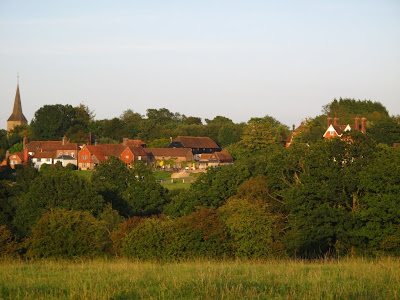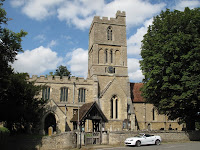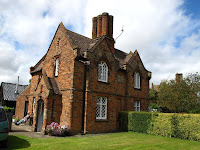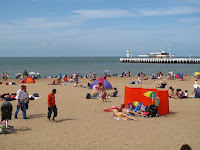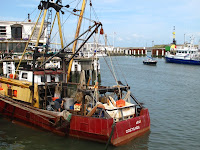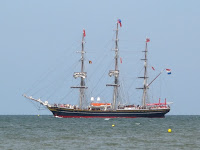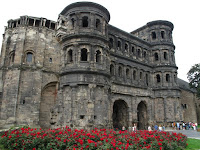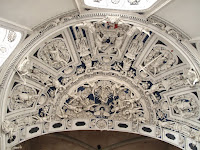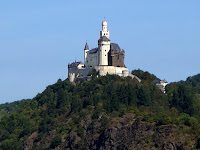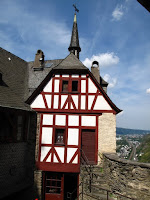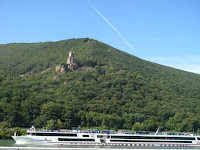 As a total contrast to yesterday, we set out from London in the opposite direction, and did a tour through the pastel plaster-coated villages of Suffolk. The tour started at Castle Hedingham, which is both the name of the village and the Norman Keep, which has the largest stone Norman arch left in the world. The Keep gives an idea of life in Norman times. The village, below the Castle, is delightful, centred around the large church.
As a total contrast to yesterday, we set out from London in the opposite direction, and did a tour through the pastel plaster-coated villages of Suffolk. The tour started at Castle Hedingham, which is both the name of the village and the Norman Keep, which has the largest stone Norman arch left in the world. The Keep gives an idea of life in Norman times. The village, below the Castle, is delightful, centred around the large church. Then on through the very attractive villages of Clare and Cavendish, to Long Melford. As the name implies, this is a long and narrow town, and at one end are two Tudor grand houses. Behind the stunning church, is Kentwell, our first stop.
Then on through the very attractive villages of Clare and Cavendish, to Long Melford. As the name implies, this is a long and narrow town, and at one end are two Tudor grand houses. Behind the stunning church, is Kentwell, our first stop. This is a huge imposing Tudor house, which has been altered by subsequent owners, and most unusually, even has new alterations by the current owners. The house is open to the public, and you can literally wander throughout most of the house in a very relaxed and unsupervised fashion.
This is a huge imposing Tudor house, which has been altered by subsequent owners, and most unusually, even has new alterations by the current owners. The house is open to the public, and you can literally wander throughout most of the house in a very relaxed and unsupervised fashion.Over the road is the much more conventional Melville Hall.
 This house is also still lived in, but under the care of the National Trust. The owners have kept the imposing traditional interiors, so the overall feel is conservative, in total contrast to their near neighbours.
This house is also still lived in, but under the care of the National Trust. The owners have kept the imposing traditional interiors, so the overall feel is conservative, in total contrast to their near neighbours. 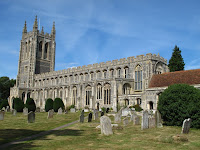
The tour then took us to Lavenham. This is a stunning town, and like all the others visited today, was involved in the wool trade. This created great wealth and prosperity in the middle ages, which accounts for the fabulously ornate churches each of these relatively small towns have.
 Lavenham was the source of 'Lavenham Broad Cloth' making it a world renowned weaving town but when the industrial revolution took place, rivers were required to power the new looms. Lavenham had no river, and the hand looms were not competitive in the new markets. The town died, and was left in a time warp, which now makes for a very appealing town of half timbered buildings.
Lavenham was the source of 'Lavenham Broad Cloth' making it a world renowned weaving town but when the industrial revolution took place, rivers were required to power the new looms. Lavenham had no river, and the hand looms were not competitive in the new markets. The town died, and was left in a time warp, which now makes for a very appealing town of half timbered buildings.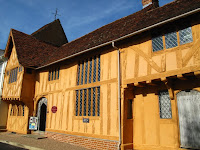 We visited Little Hall, which was restored by identical twins in the 1930s. These twins had an interesting connection with New Zealand, as they volunteered in the Great War, and served at Gallipoli. One, a Colonel and the other a medical Major. The Colonel had Anzacs serving under him, with which he had a love-hate relationship. He loved their natural skills as soldiers, but hated their informal outlook and their reluctance to conform to army discipline.
We visited Little Hall, which was restored by identical twins in the 1930s. These twins had an interesting connection with New Zealand, as they volunteered in the Great War, and served at Gallipoli. One, a Colonel and the other a medical Major. The Colonel had Anzacs serving under him, with which he had a love-hate relationship. He loved their natural skills as soldiers, but hated their informal outlook and their reluctance to conform to army discipline. The final stop of the day was totally unassociated with the wool trade. Little Maplestead is an unpretentious small town, which has a round church associated with the Knights Templers, who established a hospital nearby. The benefactor who funded the church, saw the style on his own trip to the Holy Land on the Crusades.
The final stop of the day was totally unassociated with the wool trade. Little Maplestead is an unpretentious small town, which has a round church associated with the Knights Templers, who established a hospital nearby. The benefactor who funded the church, saw the style on his own trip to the Holy Land on the Crusades.






